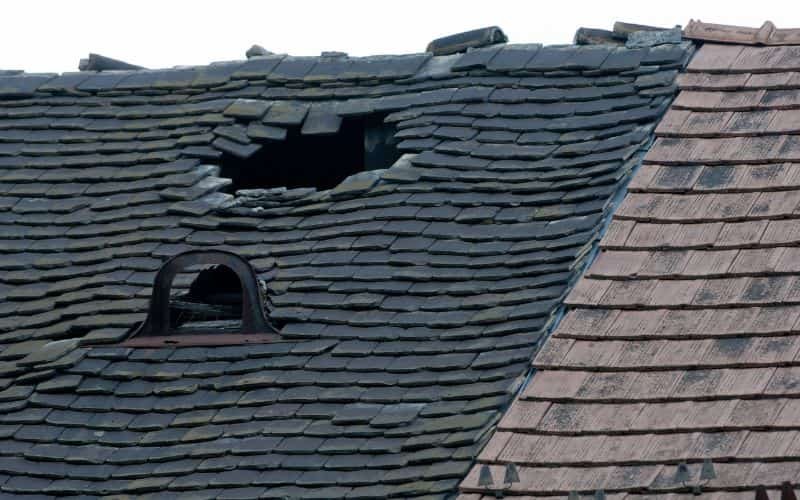Are you witnessing ceiling leaks in heavy rain? If you’re looking for effective and efficient ways to stop the roof leak and keep the inside of your home dry and clean then this blog is for you.
To start with, it is important for you to have a sound knowledge of how roof leaks occur at the first place and then understand the process of stopping these leaks. You must also consider factors such as external and internal leaks that makes it easy for water to sneak into your house.
With our wisdom and your little effort, we can fix these leaks and get your roof back into shape and create a more comfortable environment in your living room.
Without further ado, let’s dive deep into learning about how to stop roof leaks in heavy rain.

How to stop a roof leak in the rain?
Heavy rainfall and strong winds can cause some huge damage to your property. Roof damage and nasty leaks are also a result of this, that if not fixed quickly can prove to become a serious threat to your safety. As a resident and house owner, you should know how to handle this situation and stop the leaks to limit the amount of damage it might cause. Read through the blog to learn how to stop a roof leak in heavy rain!
The First Plan Of Action
Identify The Source Of Leaking Water
In order to stop roof leaks in heavy rain, you must be aware of what is allowing the water to get into your home at the first place. By doing so, you’ll know exactly how big the problem is and which tools are needed in fixing these leaks.
Start off with checking your attic as many leaks can be traced back to the attic. If possible, then get into the insides of your attic. However, you have to protect yourself. Don’t even think of going ahead with this plan if you have a rickety ladder or the flooring above is weak.
Once you get inside the attic, you are going to search for leaks or other suspicious damage that rainstorm might have caused. With this new perspective of how much water has accumulated and how much has entered inside, you will be able to slow down the spread of water from causing more internal damage to your interior roof.
For this, you’ll need something to hold that water and contain it till further repair is done. Bucket and bins are a great option as once you keep them underneath the leak, they will prevent the water from spreading and give you some time to think of a more permanent solution. However, it is important to understand that the buckets placed should be monitored in regular intervals and the surface underneath buckets should be sturdy.
Why we’re emphasizing so much on this while guiding you with how to fix roof leaks in heavy rain? The reason behind it is that, if you leave the buckets unchecked or place the bucket on already weaker surface of the ceiling, the weight of the bucket filled with water will eventually get heavier and very soon can break through the ceiling altogether.
If buckets are not working for you, then you can also try to patch the leak from the inside. You will easily find many products that are designed for specifically this type of repair.
If for any reason you’re unable to get into your attic then the second best way to get an idea of how big the damage is heading up to the roof. But keep in mind that this should not be done at the time of heavy rainstorm and even after the rain has gone and the weather seems to clear, it is important to beware as you’re still heading towards an unstable terrain shook by the heavy rainfall and rough winds.
However, if you’re still willing to take the risk and insist on venturing into the roof, here’s a list of things you should keep in mind before doing so.
- Don’t hurry, wait till the weather gets better and the storm passes away.
- Check your tools and make sure that you’re using a sturdy ladder, wearing sturdy shoes and rubber gloves.
- You can put some tarp over the leaking area and secure it so that it does not blow away.
- You can also uses patches for exterior roof similar to that of patches used in interior roofs.
Again, these repairs are temporary and will not hold on for long period of time. Sooner or later, you’ll need to hire a professional to do the work. But the entire idea is to slow down the roof leaks in heavy rain until the weather gets better so that you can enjoy the comfort of living in a clean dry space.

5 Key Steps To Repairing A Leaking Roof
After you’ve successfully identified the source of leak, it’s now time to act upon it.
1. Clear The Space
Start clearing the area and preparing it for repair as soon as you get an idea of where the water is leaking from the roof. By doing so, you will be able to reduce the damage caused by roof leaks to your furniture and other essentials.
Also ensure to move other appliances especially the electronics out of the way of the water leak. If the furniture is too heavy to lift or move then you can simply cover it with a plastic bag.
Once you’ve cleared the area, you can now mop the wet region under the leak and place containers to catch the extra water coming through the roof.
2. Apply Roof Tar
While dealing with repair of internal leaks, you should first access the outsides of your roof. One way of doing this is by using removable tiles and maintaining them in good shape. You can just simply take out these tiles and then apply roofing tar over the leaks to seal the leak in the internal ceiling.
These roofing tars are readily available everywhere across USA but one thing that you should keep in mind is that these tars perform better when used with materials such as pieces of plywood or shingle.
3. Cover The Leaks With Polyethylene
Materials like Polyethylene AKA PE plastic are of great use when it comes to covering the roof leaks in heavy rain. The reason? Because of there composition they can hold onto water leaks at places where the source is harder to find.
To use PE Plastic, all you need is a ruler to measure and a cutter to cut the pieces according to the requirement. It is highly recommended to use at least three to four layers of plastic to minimize future leaks.
4. Change Your Shingles
If the previously installed shingles are in bad condition then it’s time for you to install new shingles. Shingles with bruises and pieces missing make it easier for that rain water to sneak into your home.
While changing the old shingles with new ones, make sure to wear rubber boots and gloves to avoid any cuts. Also use a steady ladder to avoid slipping down. Use the nail remover of hammer to remove old shingles to stop roof leaks in heavy rain and then apply the new ones along with roofing tar.
5. Cover The Roof With Tarpaulins
If you live in an area that experiences storms and heavy rainfall then covering your roof with tarpaulins can come in handy. The size of these tarpaulins will depend on the size of your rooftop and the number of leaks. If your roof is large or has multiple leaks then we advise that you should use multiple tarps as well.
Cover your roof with these tarps and anchor them with heavy concrete blocks or nails. At the end, cover all the chimneys and valleys with sealant of cement. Save the sealant for smaller leaks as well that might appear in near future.
We cannot stress this enough– During the entire act of repairing your roof leak in heavy rain, ensure your safety first. Do not hurry while trying to repair your ceiling. Waiting for the heavy rainstorm to pass will not make a huge difference. So try to wait till the weather gets better and even then take all necessary precautions.
Final Thoughts

Some Jobs Should Better Be Left On Professional To Handle
As they say Precaution Is better than cure. Especially when it comes of water proofing your rooftop. Although, even after taking every possible precaution that you could have taken, the chances of you meeting with leaky roof during heavy rainfall is still there. In this scenario, it’s better to be prepared to handle any leaks as they soon as they arise. You can follow the steps we’ve listed above in the blog but if it still cause problems, then you might want to seek professional assistance.











